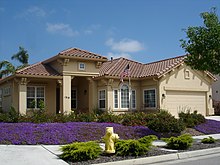This article needs to be updated. (February 2015) |



| Part of a series on |
| Living spaces |
|---|
 |
The homeownership rate in the United States[1][2] is the percentage of homes that are owned by their occupants.[3] In 2009, it remained similar to that in some other post-industrial nations[4] with 67.4% of all occupied housing units being occupied by the unit's owner. Homeownership rates vary depending on demographic characteristics of households such as ethnicity, race, type of household as well as location and type of settlement. In 2018, homeownership dropped to a lower rate than it was in 1994, with a rate of 64.2%.[5]
Since 1960, the homeownership rate in the United States has remained relatively stable. It has decreased 1.0% since 1960, when 65.2% of American households owned their own home. Additionally, homeowner equity has fallen steadily since World War II and is now less than 50% of the value of homes on average.[6] Homeownership was most common in rural areas and suburbs, with three quarters of suburban households being homeowners. Among the country's regions, the Midwestern United States had the highest homeownership rate and the Western United States had the lowest.[2] Recent research has examined the decline in homeownership rates among households with "heads" aged 25 to 44 years. The rates fell substantially between 1980 and 2000, and recovered only partially during the United States housing bubble of the early 2000s. This research indicates that a trend toward marrying later and the increase in household earnings risk that occurred after 1980 account for a large share of the decline in young homeownership.[7]
In general, homeowners in the United States also tend to have higher incomes. Households residing in their own home were more likely to be families (as opposed to individuals) than were their tenant counterparts.[8] Among racial demographics, White Americans had the country's highest homeownership rate, while African Americans had the lowest homeownership rate. One study shows that homeownership rates appear correlated with higher education attainment.[9]
The name "homeownership rate" can be misleading. As defined by the US Census Bureau, it is the percentage of homes that are occupied by the owner. It is not the percentage of adults that own their own home. This latter percentage will be significantly lower than the homeownership rate. Many households that are owner-occupied contain adult relatives (often young adults, descendants of the owner) who do not own their own home. Single building multi-bedroom rental units can contain more than one adult, all of whom do not own a home.
The term "homeownership rate" can also be misleading because it includes households that owe on a mortgage. Which means that they do not fully own the equity in their own home, which they are said to "own". According to ATTOM Data Research, only "34 percent of all American homeowners have 100 percent equity in their properties — they’ve either paid off their entire mortgage debt or they never had a mortgage".[10]
According to CNBC, the median sale price for a U.S. home in 2017 was US$199,200.[11] By February 2023, the median sale price increased to US$392,000 according to Statista.[12] The growing U.S. housing shortage is a major factor in home prices increasing so rapidly.[13][14]
- ^ "US Census Bureau, Homeownership by Area". Census.gov. Retrieved January 6, 2010.
- ^ a b "US Census Bureau, Homeownership in the United States, 1960-2004". Census.gov. Retrieved October 5, 2006.
- ^ "What is homeownership rate? definition and meaning". BusinessDictionary.com. Archived from the original on July 23, 2016. Retrieved October 14, 2017.
- ^ "EU homeownership rates, 2002" (PDF). Archived from the original (PDF) on June 16, 2007. Retrieved February 15, 2007.
- ^ "QUARTERLY RESIDENTIAL VACANCIES AND HOMEOWNERSHIP, FIRST QUARTER 2018" (PDF). Census.gov. April 26, 2018.
- ^ Federal Reserve report shows homeowner equity dipping below 50 percent, lowest on record, SignOnSanDiego.com, URL accessed 28 December 2008
- ^ "Why Has Home Ownership Fallen Among the Young?" (PDF). Chicagofed.org. Retrieved October 14, 2017.
- ^ "US Census Bureau, distribution of homeowners among the income quitniles". Archived from the original on July 7, 2006. Retrieved October 5, 2006.
- ^ "A Note on the Benefits of Homeownership, Federal Reserve Bank of Chicago" (PDF). Chicagofed.org. Retrieved October 14, 2017.
- ^ "American homeowners are making headway on mortgage debt, report finds". WashingtonPost.com. August 23, 2017. Retrieved July 7, 2019.
- ^ Martin, Emmie (June 23, 2017). "MONEY Here's how much housing prices have skyrocketed over the last 50 years". CNBC. Archived from the original on March 28, 2023. Retrieved April 6, 2023.
- ^ "Median home price in the U.S. 2022 and forecast until 2023".
- ^ "U.S. Housing Shortage: Everything, Everywhere, All at Once | Fannie Mae".
- ^ "The US housing shortage is 'awful' and will likely get worse with no apparent end in sight". USA Today.
© MMXXIII Rich X Search. We shall prevail. All rights reserved. Rich X Search
